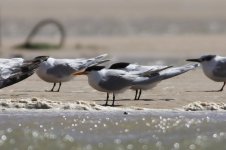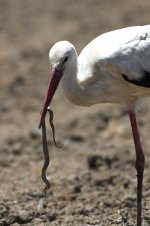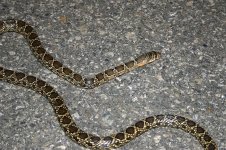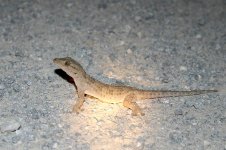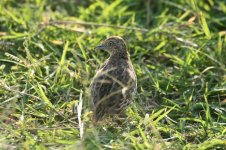17 May. Tarifa-bound
This had the makings of a right naff day, at least initially! After waking nice and early with ideas to take the short trundle to a wetland only a half hour away, a reported haunt of White-headed Ducks, Red-knobbed Coots et al, we arrived to find access was now basically non-existent and the lake distant, hmm. After a nod from the owner, nipped through a neighbouring vineyard, so did get to see the White-headed Ducks, plus a Purple Swamphen, but the views were hardly qualified as amazing! No worries, the whole day still stretched before us.
Onward we decided to plough. Barcelona F.C. had taken the Spanish league the evening before, no self-respecting Spaniard was going to be out on the roads so early, so the streets were deserted, a most pleasant cruise ahead I thought. Destination number two, Laguna de Medina, another site supreme for White-headed Duck, lay just 20 km east, half hour at most. Then I hit roadworks approaching the A4 highway, the roadworks being the complete removal of the road and totally unsigned diversions via everywhere! Ended up taking a most unscenic detour via Jerez de la Frontera, the journey taking nearer an hour. Fortunately, Laguna de Medina was worth the hassle, a most pleasant little wetland oasis in otherwise rolling agriculture. From the car park, Red-rumped Swallows buzzing into a culvert, then a stroll along the lakeside trail - Iberian Water Frogs croaking in small pools, Woodchat Shrikes on snags, Cetti’s Warblers and Nightingales in full voice. On the pool itself, a large reed-fringed affair, birds bobbed aplenty - numerous Common Coots stretched into the distance, my now virtually ex-scope not assisting in a search for red-knobbed cousins. Still, all much closer, ample compensation with up to 45 Red-crested Pochard and a half dozen White-headed Duck, plus at least 45 Black-necked Grebes. A lengthy pause in the hide added a few more birds, not least a small colony of Spanish Sparrows, busy in the reeds immediately adjacent to the hide.
Then came the next bit of naffness for the day - my partner in crime realised they had left their wallet and money back in the hotel, dimball! Back we went, via the roadworks again, only to arrive to a locked and deserted hotel. Much banging and several phone calls later, a groggy voice appears on the intercom - they pressed a buzzer, we gave the door a good kick, so it opened. Oh well, back in Rota, thought it would be nice to revisit the botanical gardens to find more Chameleons in the sparkling sunshine. Rats, it was Monday and the gardens were closed!!!
Enough of this, hit the highway and cruised south all the way to Tarifa, a storming wind ensuring all the boat trips there were cancelled, so no chance of adding any dolphins to the trip. Hmm, what to do? A quick coffee in Tarifa town, admiring the Lesser Kestrels to and fro from the town’s castle, then a stroll along the town’s beach. This is where the day took a distinct upturn - after a lengthy stroll with nothing much to note, a group of distant terns was spotted loafing on the beach. Another ten minutes and I was bunkered down on the beach admiring them, 45 Sandwich Terns and one stonking yellow bill in the middle of them - a Spanish rarity, one Lesser Crested Tern, very nice indeed. Though this beach is the single best locality for them in Spain, the records tend to be few and far between, most typically limited to a handful of records per spring. With time to kill, we now backtracked to La Janda, extensive grasslands a little to the west of Tarifa - excellent for birds, but blighted by the encroachment of hundreds of wind turbines, a criminal intrusion into such a vital area for raptors and storks. Most famed for its huge stork concentrations at migration times, the area still nonetheless was rich in birds, particularly the areas further inland, beyond the wind farms. Amongst many birds seen, raptors galore - a number of Black Kites, a Montagu’s Harrier, two Short-toed Eagles, four Booted Eagles, three Egyptian Vultures and several Griffon Vultures, a bird at every turn. Also numerous White Storks, one busy in the process of dispatching a snake, plus a Collared Pratincole and numerous Crested Larks, along with smaller numbers of Lesser Short-toed Larks and Calandra Larks. Also notched up two Large Psaammodronas, a welcome addition to the day’s tally.
So the afternoon was nearing its end, where better to position myself than on the hills above Bolonia, adjacent to the famous swift cave. Site of the initial colonisation of Europe by both Little and White-rumped Swifts, both still breed in the cave and should I find the former, my quest for a ‘five up’ on the swifts this trip would be accomplished. A most scenic locality, it was also very nice for birds - Blue Rock Thrushes dashing about, Griffon Vultures drifting over almost constantly, a small passage of Honey Buzzards filtering in very late afternoon, late arrivals from the African continent just across the blue waters. All remained quiet at the cave. I however had little to fear - sunset should bring the swifts to roost …and indeed it did - with an hour to spare, after watching countless Common and Pallid Swifts, in fluttered two Little Swifts, their aerial show lasting a good half hour, swooping in and out of the cave, one eventually disappearing in, not to return. Fabulous, all five swift species on a single trip!
With that, returned to Tarifa, had a drink and waited dark - the idea a nocturnal transit to our next destination, hopefully critters of the night to enhance the journey. The sun sank, we ventured off into the hills beyond Tarifa. Three hours slowly winding the tracks and trails, a Horseshoe Whip Snake the first major bonus, Red-necked Nightjars the next, a total of five seen, one photographed. Also one Turkish Gecko (complementing the Moorish Geckos already seen), one huge Common Toad and one Tawny Owl. Arrived late somewhere by a lake, slept in the car.





